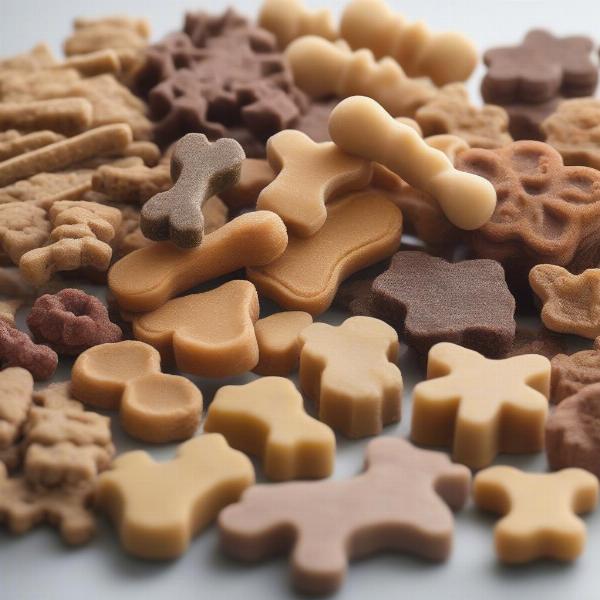Soft dog treats are a versatile and popular training tool, reward, and even medication delivery system. They’re perfect for puppies, senior dogs, or dogs with dental issues who might struggle with harder treats. But with so many options on the market, how do you choose the best soft dog treats for your furry friend? This guide will help you navigate the world of soft dog treats, covering everything from ingredients and benefits to training tips and special considerations.
Understanding the Benefits of Soft Dog Treats
Why choose soft dog treats over other types? Soft treats offer several advantages:
- Easy to chew and digest: Perfect for puppies, senior dogs, and those with sensitive stomachs or dental problems.
- Highly palatable: Their soft texture and often intense aroma make them irresistible to most dogs.
- Ideal for training: Their small size and quick consumption make them perfect for reward-based training.
- Versatile: Can be used for medication administration, hiding pills within the soft texture.
- Great for bonding: Offering a soft treat is a gentle and loving way to connect with your dog.
 Various soft dog treats for dogs
Various soft dog treats for dogs
Choosing the Right Soft Dog Treats
With a plethora of choices, selecting the best soft dog treats can be overwhelming. Consider these factors:
- Ingredients: Look for high-quality, natural ingredients and avoid artificial colors, flavors, and preservatives. Prioritize treats with real meat or poultry as the primary ingredient.
- Nutritional value: While treats shouldn’t replace meals, choose options that offer some nutritional benefits, such as added vitamins or omega-3 fatty acids.
- Size and shape: Smaller treats are ideal for training, while larger ones can be given as a special reward. Consider your dog’s size and chewing ability.
- Calorie content: Be mindful of the calories in treats, especially if your dog is overweight or on a restricted diet.
- Specific needs: Consider any allergies or sensitivities your dog has. Look for grain-free, hypoallergenic, or limited-ingredient options if necessary.
Using Soft Dog Treats for Training
Soft treats are an excellent tool for positive reinforcement training. Their small size and palatability make them ideal for rewarding desired behaviors:
- Start small: Break larger treats into smaller pieces to avoid overfeeding.
- Be consistent: Reward your dog immediately after the desired behavior to create a clear association.
- Vary the rewards: Keep training interesting by using different flavors and textures of soft treats.
- Use treats strategically: Gradually reduce the frequency of treats as your dog learns the command.
- Combine with verbal praise: Pair treats with positive words and petting to reinforce good behavior.
dog chew toys can also be incorporated into training sessions, offering a variety of textures and engagement for your dog.
Special Considerations for Soft Dog Treats
- Storage: Store soft treats in an airtight container in a cool, dry place to maintain freshness.
- Dental health: While convenient, excessive consumption of soft treats can contribute to plaque buildup. Consider supplementing with dental chews or regular teeth brushing. dog eye glasses can be a fun and stylish way to protect your dog’s eyes during outdoor activities.
- Homemade soft treats: If you’re inclined, you can make your own soft dog treats using simple, wholesome ingredients.
Conclusion
Choosing the best soft dog treats for your dog involves careful consideration of ingredients, nutritional value, and your dog’s individual needs. By following the guidelines in this comprehensive guide, you can ensure your furry friend enjoys these delicious and beneficial treats while staying healthy and happy. Remember to incorporate treats as part of a balanced diet and training regimen.
FAQ
- Can puppies eat soft treats? Yes, soft treats are ideal for puppies due to their easy-to-chew texture.
- Are soft treats good for senior dogs? Absolutely, senior dogs often have dental issues and benefit from the softness.
- Can I give my dog soft treats every day? While okay in moderation, treats shouldn’t replace a balanced diet.
- How should I store soft dog treats? Store in an airtight container in a cool, dry place.
- What are some good ingredients to look for in soft treats? Real meat, poultry, fruits, and vegetables are excellent choices.
- How can I use soft treats for training? Use them as positive reinforcement, rewarding desired behaviors immediately.
- Are there any potential downsides to soft treats? Overconsumption can contribute to dental issues, so moderation is key.
dog anxiety bed can provide comfort and security for dogs experiencing stress or anxiety.
More helpful resources on ILM Dog:
About ILM Dog: ILM Dog is your trusted resource for all things dog-related. We provide expert advice on dog breeds, health, training, nutrition, and more. Whether you’re a new dog owner or a seasoned expert, we’re here to help you provide the best possible care for your canine companion. Contact us at [email protected] or +44 20-3965-8624 for personalized guidance on choosing the right products and services for your dog.